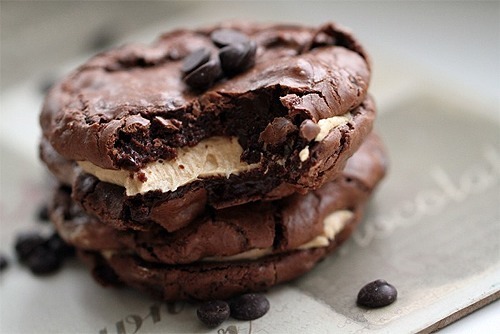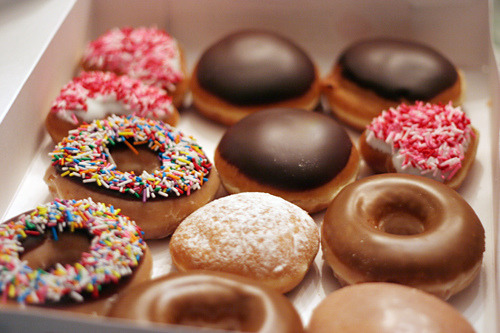A craving is defined as “a powerful desire.” Our cravings drive us, whether for love, money, power, fame, or simply those sea salt caramels.
Cravings for things like cabbage or baby carrots are rare (and if you have them, I salute you). Instead, cravings are usually for foods high in fat, sugar, or carbs (hello, chocolate covered pretzels!) which, when ingested, trigger the release of natural opioids and give us a sense of pleasure—a kind of mini-high. Indeed, areas of the brain associated with drug craving light up when people crave a specific food. Furthermore, blocking opiate receptors in the brain cuts cravings for fat and sugar.
Hormones play a role in cravings, too. Ghrelin, the hunger hormone, naturally goes up and down before and after a meal. But evolutionarily, ghrelin is still living on the plains from our hunting and gathering days—it plays a role in our natural preference for sugar, as well as our likelihood of giving in to cravings for comfort foods.
Ghrelin may also keep us from stopping at just one serving of Chubby Hubby: A 2013 study found that ghrelin levels followed a typical rise-and-fall pattern after eating a relatively boring meal, but rocketed off the charts after eating yummy deliciousness (specifically, cake with rum syrup, custard, and Nutella) even after the study participants were full. This suggests that ghrelin drives what researchers call “hedonic food consumption,” which is what’s happening when your chocolate croissant feels suspiciously like pastry-wrapped crack. In a hormonal double whammy, eating for pleasure also went along with decreased levels of the hormone that influences satiety. This might have been helpful in past millennia, but is not helpful when you work across the street from Krispy Kreme.
Eating to satisfy a craving is different than a binge. Cravings can set off a binge, but they don’t have to. A binge feels out of control and is often driven by stress, worry, shame, or boredom. It is often, but not always, associated with using food to fill an emotional void or managing seemingly unmanageable emotions.
Cravings, by contrast, aren’t necessarily driven by emotion, but they can get mixed up with them. Craving for a specific food often goes hand-in-hand with other feelings, and knowing what you’re dealing with is the first step to prevention. To that end, here are 4 wolves in the sheep's clothing of cravings:
Craving Culprit #1: Emotional Eating
Emotional eating is also called stress eating. Both cravings and emotional eating reflect a strong desire, but with a craving, the object of desire is the specific food—you want something very particular, and a different food isn’t going to do the trick. By contrast, the point of emotional eating is simply the act of eating, whether to burn nervous energy, soothe yourself, or stuff a feeling of emptiness. A specific food might be preferred, but any food will do, as Oprah’s famous incident with frozen hot dog buns and syrup attests.
Craving Culprit #2: Boredom
If you’re a creature of habit, eating the same foods day in and day out might be a comfort. But for those who do better with variety, restricting yourself to foods that are familiar or convenient lights a fire under cravings. A study in the journal Physiology and Behavior found that “dietary monotony,” even when it meets all nutritional needs, triggers cravings. This often happens to dieters; folks on a diet often eat the same few things because the foods are “permissible” or they already know the caloric content. This can lead to boredom, which can trigger a craving.
Craving Culprit #3: Deprivation
By the same token, dieters often forbid “bad” foods. However, disallowing certain foods works like thought suppression, which is to say it doesn’t. For example, try not to think about a pink elephant floating above your head. Don’t worry—I can’t do it, either. Now, try not to think about steak frites. Because you have to remember what you’re not supposed to think about—or what you’re not supposed to eat—it’s always on your mind.
If you feel deprived when you try to group foods as “healthy” versus “unhealthy” or “good” versus “bad,” you may be setting yourself up for cravings. Eat what you like in sensible amounts, before the sense of deprivation builds up.
The big asterisk to this statement is that for some, the abstinence model really does work best. If you cannot eat just one Oreo without triggering a Cookie Monster free-for-all, and you’re comfortable with never having them in the house, simply don’t buy them. Your life will be easier for it.
Craving Culprit #4: Plain Old Hunger
If it’s been more than a few hours since you’ve eaten, it might not be a craving, per se', but simple hunger. The difference: hunger is satisfied by many foods, while a craving is squelched by one particular food. So if everything in the deli case looks good, you’re probably just hungry. Also, a craving eventually passes, but hunger just gets worse. So nourish yourself. And if you’re hungry for something specific, enjoy.
Now, what do you do when the siren song of garlic breadsticks is leading you to certain doom? Here are 7 tips to navigate the waters:
- Tip #1: Remember a craving is not an emergency. Rather than getting swept up in the urgency of “I need it now!” let the craving perch on your shoulder and carry it around for a while. Like a storm, cravings fizzle and pass. Welcome it as a temporary visitor rather than fighting it like an enemy.
- Tip #2: Lean in. To resist the craving, use a counter-intuitive tool and lean into the craving. Your body may need acknowledgement and attention, not Fritos. Breathe. Calmly notice and describe the craving in undramatic terms. You may uncover some other need under the craving, or you may not; it’s the tuning in that will tell you.
- Tip #3: Delay. Some cravings are like a firecracker—a quick pop and they dissolve. But others are a slow burn—they smolder on for hours and days if not fulfilled. To deal with the firecracker variety, tell yourself you can have those salt and vinegar potato chips in half an hour. Fast forward to your target time and you may have forgotten about them. If you still want them, maybe you’ve got the slow burn. Into the shopping cart they go, but do the following:
- Tip #4: Ladies, talk it out; gentlemen, keep it to yourself. A 2008 study found that when women tried to suppress their thoughts about chocolate, they actually ended up eating 50% more than those who were encouraged to think and talk about it. For men, however, the response was different—those who thought and talked about the chocolate ended up eating more than those who suppressed.
- Tip #5: Don’t try to substitute. If I want a cookie but eat a carrot, I’m guaranteed to end up eating a carrot and, a few minutes later, a cookie. Or four. I’m willing to bet you’re similar. If you’re craving something, don’t try to fool yourself. Your body and taste buds are smart, and they will get mad if you try to trick them.
- Tip #6: Create a mini ritual for your favorite foods. Engaging in ritual around food makes it more enjoyable. Lighting candles, singing “Happy Birthday,” and making a wish really does make the cake taste better. But it works on a smaller scale, too. In a 2013 study from the University of Minnesota, something as small as opening a chocolate bar in a specific way made the participants savor the chocolate longer, rate it more highly, and pay more for it. Do the same and create a ritual around foods you crave to maximize your enjoyment. You don’t have to do an elaborate donut dance; it could be as simple as always breaking the donut in half before you eat it.
- Tip #7: Savor it. When you finally get your hands on that kettle corn, really taste it. Eat it slowly. Sit at a table, but not in front of a screen. Chew, don’t inhale. Taste each ingredient. This is called mindful eating and it can be both freeing and frustrating. The tendency to plow through a meal without tasting it is so common that it feels odd to slow down, but eating mindfully can decrease your cravings, your waistline, and your risk of Type 2 Diabetes. But not to worry—your food doesn’t have to be fancy, vegan, or organic—you can eat anything mindfully, even your kids’ pizza crusts (not that I know anything about that...)
So when a craving strikes, calm down, tune in, and savor every bite. With some practice, that tractor beam from the cookie jar may be weaker than you remember.
Source
http://www.quickanddirtytips.com/health-fitness/mental-health/how-to-handle-food-cravings
References
Drewnowski, A., Krahn, D.D., Demitrack, M.A., Nairn, K., & Gosnell, B.A. (1995). Naloxone, an opiate blocker, reduces the consumption of sweet high-fat foods in obese and lean female binge eaters. The American Journal of Clinical Nutrition, 61, 1206-12.
Erskine, J.A.K. (2008). Resistance can be futile: Investigating behavioural rebound. Appetite, 50, 415-421.
Hanh, TN., Cheung, LWY. Savor: Mindful Eating, Mindful Life. Harper One, New York, 2010.
Monteleone, P., Scognamiglio, P., Monteleone, A.M., Perillo, D., Canastrelli, B., & Maj, M. (2013). Gastroenteric hormone responses to hedonic eating in healthy humans. Psychoneuroimmunology, 8, 1435-1441.
Pelchat, M.L. & Schaefer, S. (2000). Dietary monotony and food cravings in young and elderly adults. Physiology & Behavior, 68, 353-359.
- See more at: http://www.quickanddirtytips.com/health-fitness/mental-health/how-to-handle-food-cravings?page=1#sthash.WcNFi2Sz.dpuf











No comments:
Post a Comment